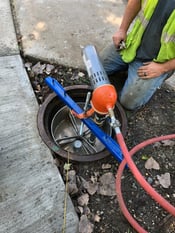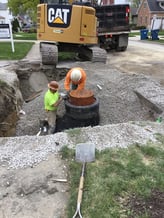(630) 682-4700
2655 Warrenville Road, Suite 225, Downers Grove, IL 60515
Better information about your collection, water, and stormwater systems
Explore ClarityBetter information about your collection, water, and stormwater systems
Explore ClarityThis article was originally published in the November 2021 edition of Underground Construction Magazine.

Ms. Giokas offers a diverse engineering background in wastewater collection sy...
NASSCO has elevated and standardized the approach for inspecting sewer assets, both sewers using Pipeline Assessment Certification Program (PACP™) standards and structures using Manhole Assessment Certification Program (MACP™) standards. However, once a structure inspection has been performed, how do you get to a rehabilitation program and develop specifications for bidding?
Assuming that the inspection and attribute data collection was performed using MACP standards, the data needed for developing a specification is readily available and includes:
Adhering to MACP standards is highly recommended for creating a homogenous dataset for assets systemwide and across various inspection crews or contractors. One additional piece of requisite asset data, floodplain status, comes from FEMA floodplain maps. Once you have acquired all of this information, you can begin to build your rehabilitation plan.
Several considerations must be addressed to narrow down the field of available rehabilitation options before the process advances further:
 With these questions answered, initial rehabilitation methods can be developed and then grouped by type or location into a project that fits within the owner’s budget. Typical manhole rehabilitation methods include:
With these questions answered, initial rehabilitation methods can be developed and then grouped by type or location into a project that fits within the owner’s budget. Typical manhole rehabilitation methods include:
Additional options include the installation of barrel sections, complete manhole replacement, or performing O&M work such as cleaning or root removal.
Preliminary rehabilitation recommendations may require adjustment based on additional external factors, such as being located within a brick driveway, state highway, or floodplain. Manholes in a 100-year flood zone have requirements to raise the rim elevation above the base flood elevation or install a bolted frame or sealing cover.
Some items will be incidental to the cost of an existing bid item. For example, for sewers under 15 inches in diameter, bypass pumping will likely be incidental. For larger sanitary sewers, bypass pumping is often listed as a separate line item. Reconstruction is another activity that may be incidental; however, more extensive work may be listed as separate line items, such as seed/sod, asphalt, concrete, etc.
All of the rehabilitation recommendations that the owner is not performing will be included as separate items in the bid tabulation. And each item will identify how it is to be measured and paid: per each, per linear foot, per cubic yard, etc.
The technical specifications specific to the project will contain the details of each rehabilitation method, including materials, installation requirements, testing requirements, etc. The specifications also need to define submittals and testing required, as well as warranty considerations.
Submittal requirements, testing needs, and the desired warranty period must be defined within the specifications to ensure that the work is being performed correctly and that the rehabilitation will meet its expected service life.
Submittals may be required before, during, or after the specified rehabilitation. All submittals should be reviewed to ensure compliance with the specification. Submittals may be calculations, material submittals, samples of the installed product, etc.
Testing should be conducted at the time of the rehabilitation and may involve thickness testing or vacuum testing. These are defined by the manufacturer or ASTM standards.
Rehabilitation products are typically warrantied for one year, but that timeframe can be extended for an additional cost. Extended warranties should be included as a separate bid item. If the owner desires a warranty extension, they need to have the capacity and capability to perform asset inspections in the months before the end of the warranty.
 The technical specifications will get rolled into the entire bid package to be advertised. Manhole rehabilitation is specialized work and is usually bid as a separate project or sub-contracted out if it is included in a larger project.
The technical specifications will get rolled into the entire bid package to be advertised. Manhole rehabilitation is specialized work and is usually bid as a separate project or sub-contracted out if it is included in a larger project.
While manholes are generally taken for granted, ensuring they operate as designed is vital to ensuring sewer systems can be maintained and adequately convey flows. Regular inspections using MACP standards and then following up and rehabilitating structures with deficiencies are required to keep manholes performing in the sewer system as intended.

Ms. Giokas offers a diverse engineering background in wastewater collection sy...